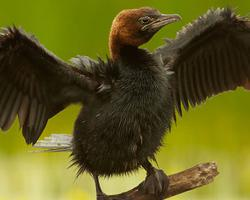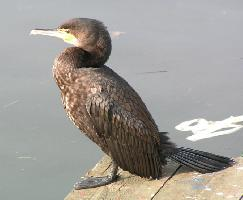
Veszélyeztetettség
| Veszélyeztetett |
Állatleírás
The Pygmy Cormorant (Microcarbo pygmaeus), a small yet distinctive waterbird, belongs to the cormorant family Phalacrocoracidae. With its limited distribution primarily in the wetlands of southeastern Europe and southwestern Asia, this species has intrigued ornithologists and bird watchers alike with its unique characteristics and behaviors.Physically, the Pygmy Cormorant is notably smaller than its cormorant relatives, measuring approximately 45-55 cm in length with a wingspan ranging from 18 to 24 inches. This size difference is significant enough to make it one of the smallest members within its family. Its plumage is predominantly glossy black during the breeding season, adorned with some green and purple iridescence, which adds a subtle yet captivating sheen. Outside of the breeding season, its feathers take on a slightly duller appearance, with more pronounced brown tones. Juvenile birds are generally paler, featuring a mix of grey and brown hues.
One of the most striking features of the Pygmy Cormorant is its long, slender neck and small head, which gives it an almost snake-like appearance when swimming. Its bill is sharp and hooked at the end, an adaptation perfectly suited for catching fish, which constitutes the majority of its diet. Additionally, its webbed feet enable it to dive and swim with remarkable agility and speed, making it an efficient predator in its aquatic habitat.
Behaviorally, the Pygmy Cormorant is a sociable bird, often found in flocks that can number in the hundreds, especially outside the breeding season. These flocks roost together in trees or on islands within their wetland habitats, creating a communal living situation that offers protection against predators. During the breeding season, however, they become more territorial and nest in smaller colonies. Their nests are constructed from twigs and are usually located in trees or reed beds close to water.
The breeding season witnesses a fascinating display of courtship behaviors, where males perform elaborate displays to attract females. These include a series of postures, vocalizations, and flights designed to showcase their strength and vitality. Following successful courtship, the female lays between 3 to 6 eggs, which both parents then incubate.
The Pygmy Cormorant's diet is predominantly piscivorous, comprising mainly of small fish, supplemented by aquatic insects and crustaceans. They are expert divers, capable of pursuing their prey underwater with remarkable agility.
Conservation-wise, the Pygmy Cormorant is considered to be of Least Concern by the International Union for Conservation of Nature (IUCN), though its populations are subject to threats from habitat destruction, pollution, and changes in water management. Wetland degradation, in particular, poses a significant risk to their habitats, necessitating concerted conservation efforts to ensure the survival of this unique species.
In summary, the Pygmy Cormorant is a fascinating bird, notable for its diminutive size, sociable nature, and impressive diving abilities. As a species, it highlights the rich biodiversity of wetland ecosystems and underscores the importance of preserving these habitats for the future.
Hasonló állatok
Új állatfotók
Top 10 állat
- Dolphin gull (Leucophaeus scoresbii)
- Diana monkey (Cercopithecus diana)
- Moustached guenon (Cercopithecus cephus)
- Galápagos tortoise (Geochelone nigra complex)
- Japanese macaque (Macaca fuscata)
- Russian tortoise (Testudo horsfieldii)
- Stone loach (Barbatula barbatula)
- Greek tortoise (Testudo graeca)
- Common flying dragon (Draco volans)
- Vendace (Coregonus albula)


